Faenza, Italy — The moment Giorgio Patuelli realised that all his possessions had been destroyed in an instant, was surreal.
“That night, when I believed I was going to drown in the stinking black waters, with the noise of streams all around me, my only thought was to save myself and my loved ones,” he says.
“When the adrenaline passed, I realised: I don’t own anything any more.”
These days, having been displaced by the catastrophic May 2023 flooding in the Emilia-Romagna region in northern Italy, Giorgio Patuelli, in his early 60s, lives with his disabled sister and elderly mother in a small, one-room apartment in the city of Faenza.
His old house, which is in another area of the city, stands empty now.
Damp permeates the bare walls, creating a sickly odour, while a layer of earthy dust covers the surfaces and floors.
 Inside Giorgio Patuelli’s water-damaged living room in Faenza [Cecilia Fasciani/Al Jazeera]
Inside Giorgio Patuelli’s water-damaged living room in Faenza [Cecilia Fasciani/Al Jazeera]
Despite his upbeat demeanour, Patuelli’s devastation shines through as he points at where his lifetime memories used to be. There’s no trace of the paintings he spent years collecting during his trips around the world, his library of books.
Almost everything he owned had to be thrown away by the volunteers who came from all over Italy to help clear through the mud in the aftermath of the flooding.
From May 1 to May 17 this year, the same amount of rain fell in the area as would normally fall in six months. It caused 23 rivers to overflow, leaving 16 people dead and 36,000 displaced in more than 40 municipalities, particularly in the Romagna area.
According to Italian hydrologist Andrea Rinaldo, the disaster highlighted the correlation between such extreme weather events and climate change because the impact of the extraordinary rainfalls was made all the more devastating by the dryness of the soil, caused by acute droughts in the past few years.
 Giorgio Patuelli stands outside his home in Faenza where flood water in May reached as high as the middle of the first-floor window and made the house uninhabitable [Cecilia Fasciani/Al Jazeera]
Giorgio Patuelli stands outside his home in Faenza where flood water in May reached as high as the middle of the first-floor window and made the house uninhabitable [Cecilia Fasciani/Al Jazeera]
Using a bed as a life raft
In Faenza, watermarks as high as five metres (16 feet) are still visible on the buildings. At Patuelli’s home, the watermark line reaches the middle of the first-floor window.
Along with his mother and sister, he was rescued by a firefighters’ watercraft through that very window at 3am on May 16 after six hours of standing in flood water. He had been using his bed as a raft to prevent his mother and sister from drowning.
Life has been far from easy in the one-room apartment they have shared since the disaster.
“In July, my mother developed a severe form of depression,” Patuelli says. “I have to take care of her and my sister, night and day. I haven’t had time to think about what to do with the house.”
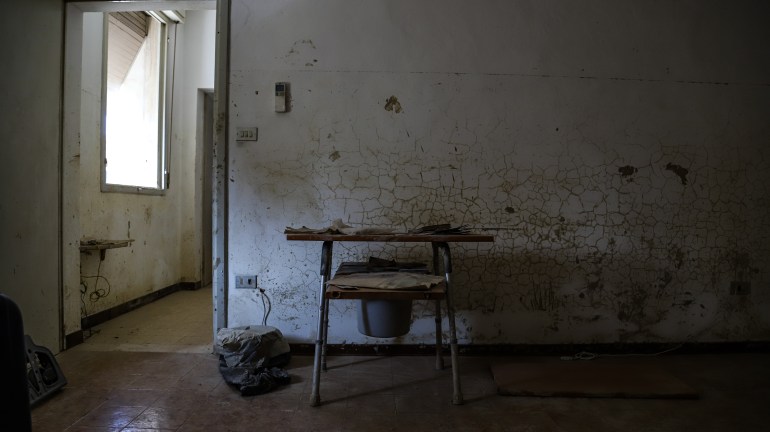 Giorgio Patuelli’s bedroom in his house in Faenza, which was so badly flooded in May, he, his elderly mother and disabled sister had to be rescued through the first-floor window [Cecilia Fasciani/Al Jazeera]
Giorgio Patuelli’s bedroom in his house in Faenza, which was so badly flooded in May, he, his elderly mother and disabled sister had to be rescued through the first-floor window [Cecilia Fasciani/Al Jazeera]
Just 50 metres (164 feet) up the road from Patuelli’s house, the river banks still bear the marks of the destruction. There is a 100-metre (328-foot) stretch of wall which has completely collapsed and washed-up rubbish and waste is still strewn everywhere.
Only a few families have so far moved back into the neighbourhood – now sandy and nearly deserted. Of the 58,000 citizens of Faenza, 1,700 were forced to relocate and, like Patuelli, now receive some small financial compensation from the government to help with the costs.
A further 100 people from the community are still staying in hotels, Faenza’s mayor, Massimo Isola, told Al Jazeera in October. So far, the city has counted some 60 million euros ($65.8m) worth of damage to public areas and infrastructure.
Some emergency repairs were carried out in the immediate aftermath of the floods – paid for out of the local municipality’s budget. But the money ran out and little has happened since.
Full repair works to the river banks and the sewage system which was badly damaged during the flooding, are only now starting with winter well on its way. “We would have liked to start immediately,” said Isola, “but we have not received a euro from the [central] government.”
 Tractors work to remove mud and sand near the riverbank in Faenza, Italy, months after the area was devastated by flooding [Cecilia Fasciani/Al Jazeera]
Tractors work to remove mud and sand near the riverbank in Faenza, Italy, months after the area was devastated by flooding [Cecilia Fasciani/Al Jazeera]
No money for repairs
The huge volumes of water that caused rivers to overflow and break the banks in the plain, first gathered high in the hills. In the Apennines mountain range, close to Faenza, soil saturated with water started sliding down, taking trees, roads and cultivated fields with it.
About 30km (18.5 miles) away, in the hillside area around Casola Valsenio, a town with 2,500 inhabitants, there were about 300 landslides in May. At the time, some nearby valleys were completely cut off for weeks, and about 20 percent of the municipality’s area was left without electricity.
“We wasted months,” said Flavio Sartoni, a council member in Casola. “All the roads and debris are [still] almost the same as they were after the emergency repairs just after the floods.”
The cost of full repairs in Casola will run to 170 million euros ($186.4m), he said.
“We were lucky, the summer was dry. But the rains now could very easily bring us back to the same situation as May,” said Sartoni. There have already been signs this may happen. At the beginning of November, a strong rainfall hit Casola again, provoking a new series of landslides and flooding some buildings.
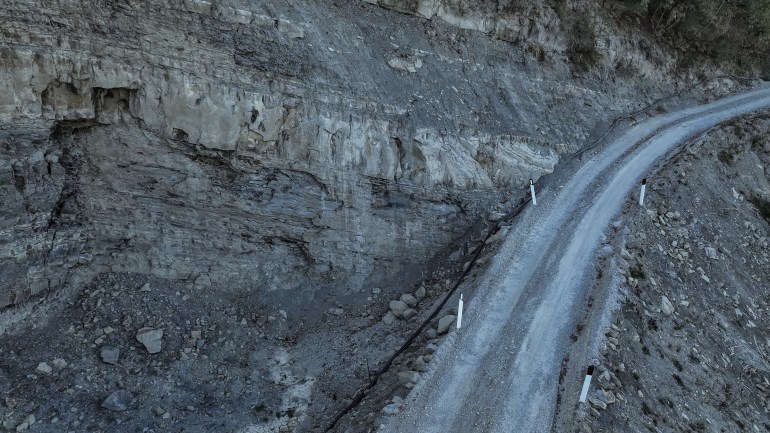 The roads around Casola Valsenio, Romagna, are still vulnerable to landslides several months after the May floods [Cecilia Fasciani/Al Jazeera]
The roads around Casola Valsenio, Romagna, are still vulnerable to landslides several months after the May floods [Cecilia Fasciani/Al Jazeera]
At the end of May, Italian Prime Minister Giorgia Meloni promised “to reimburse 100 percent of the damage” to municipalities and citizens.
However, an investigation this year by Italian news outlet Corriere della Sera revealed that access to funds had been hampered by problematic conditional clauses, delays and political squabbling between the left-wing regional authorities and right-wing national government.
In the first five months following the floods, only a very small portion of the money needed was sent to Romagna. These funds were mostly used to reimburse the local municipality offices for the emergency repairs which had already been undertaken and to provide a one-time payment of 3,000 euros ($3,281) to each family affected by the flooding.
It was only in November that the cabinet agreed to provide four billion euros ($4.4bn) over the next three years, only half the initial amount promised by Prime Minister Meloni in May.
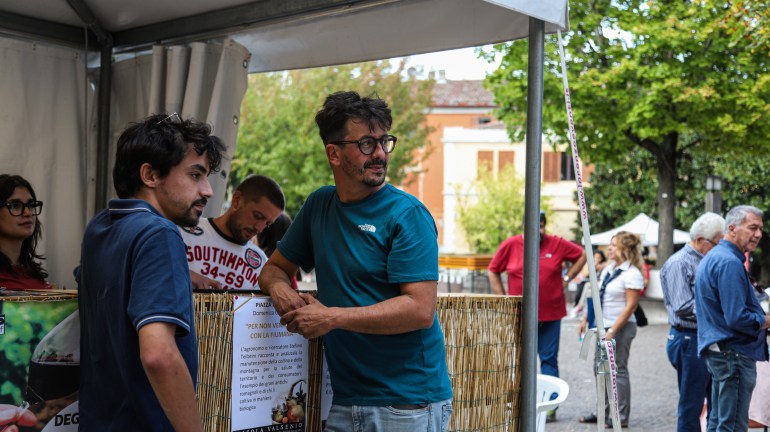 Flavio Sartoni, Casola Valsenio town councillor, with members of his community during a village festival in Casola Valsenio, Italy [Cecilia Fasciani/Al Jazeera]
Flavio Sartoni, Casola Valsenio town councillor, with members of his community during a village festival in Casola Valsenio, Italy [Cecilia Fasciani/Al Jazeera]
‘The uncertainty is killing me’
Eugenia Garuffi is one of many business owners in the area who are also waiting for funds before they can reopen. For the past 40 years, her family has run the trattoria, Al Forno, near Lugo, a small city which sits between the hills and the Adriatic coast.
It is also located right next to the Santerno River which, in May, breached at five different points, one just a few metres from her restaurant. Today, mud and rubbish remain piled up next to the trattoria and the road has been closed by the authorities. In any case, what remains of it is little more than a stretch of sand that flies up whenever cars illegally drive over it.
With taxes still to pay and a municipal order keeping her restaurant closed until the damage to the river bank can be repaired, Garuffi cannot reopen without financial support. She says all the requests for information she has sent to the municipal government office have gone unanswered. But it is the not knowing what will happen next which is the hardest to bear, she says.
“Nobody tells me when the money will arrive or the road will reopen, this uncertainty is killing me.”
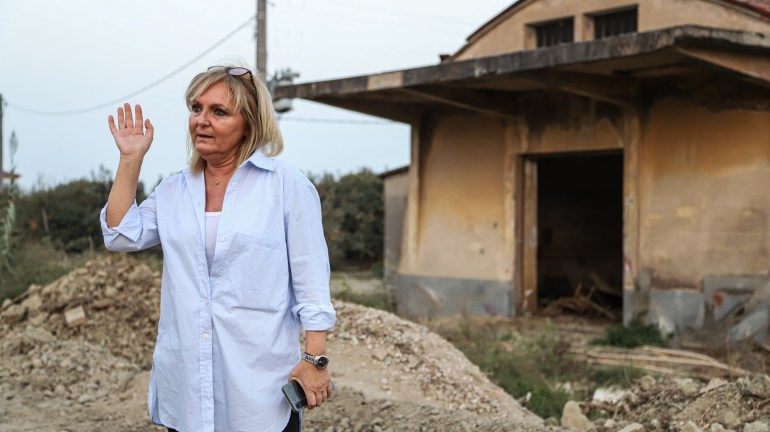 Eugenia Garuffi, owner of the trattoria, Al Forno, is still waiting to reopen her restaurant which was badly damaged by the floods in Lugo, Italy [Cecilia Fasciani/Al Jazeera]
Eugenia Garuffi, owner of the trattoria, Al Forno, is still waiting to reopen her restaurant which was badly damaged by the floods in Lugo, Italy [Cecilia Fasciani/Al Jazeera]
“Waiting can be very difficult, especially for those who are in a precarious situation,” said psychologist Antonella Liverani, who coordinated the emergency psychological support in Romagna during the floods in May.
“The flood was a collective traumatic event,” she explained. “It is a rupture with everyday life’s continuity and one’s certainties”. So, 48 hours after the flooding hit, a mental health helpline and contact points were created in different towns, reaching about 2,100 people. Thirty-nine psychologists worked on rotation to support those affected.
“First, we dealt with the symptoms of traumatic events, such as sleep disorders, flashbacks that brought back the noise of the water and the rescue dinghy for instance,” Liverani said. Some people, including children, are still experiencing these symptoms months later, and can feel completely destabilised by changes in the weather.
“The challenge has been to not pathologise what is a natural post-traumatic reaction,” Liverani said. Through group counselling that continues today and other community work, her team has managed to reach people who might have previously been reluctant to seek psychological support. “It is important that people can manage their frustration constructively, trying to make weekly or monthly plans, for instance, otherwise it can turn into anguish or anger.”
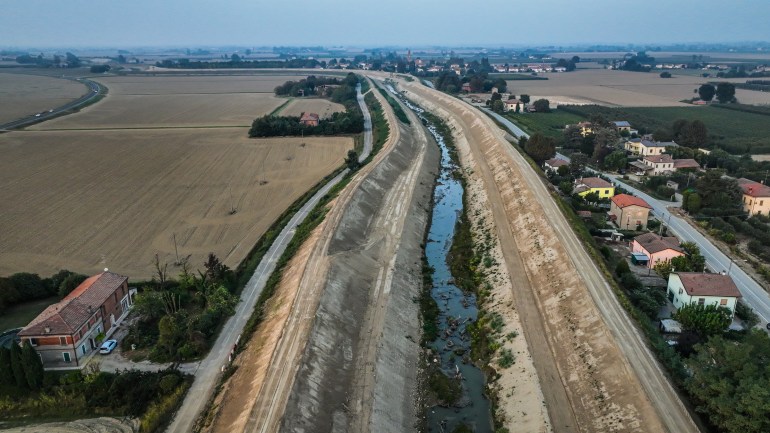 The riverbed in Lugo, near Faenza, Italy, is still filled with debris from the flooding [Cecilia Fasciani/Al Jazeera]
The riverbed in Lugo, near Faenza, Italy, is still filled with debris from the flooding [Cecilia Fasciani/Al Jazeera]
‘Rolling up our sleeves’
Some have fared worse than others in the long months following the floods.
“The flooding fell unequally on the most disadvantaged fragments of the population,” said Barbara Domenichini, coordinator of Casa delle Donne, a women’s centre based in Ravenna.
She also mentioned women who were fleeing domestic violence but who saw their lives turned upside down even more by the flooding. For instance, some women in Faenza lost their cars which would have assured their independence from abusive partners, said Domenichini.
Agricultural workers, including women, have been disproportionately affected. Domenichini described the struggles of some migrant farm labourers who have had to relocate as the fields they worked in were destroyed.
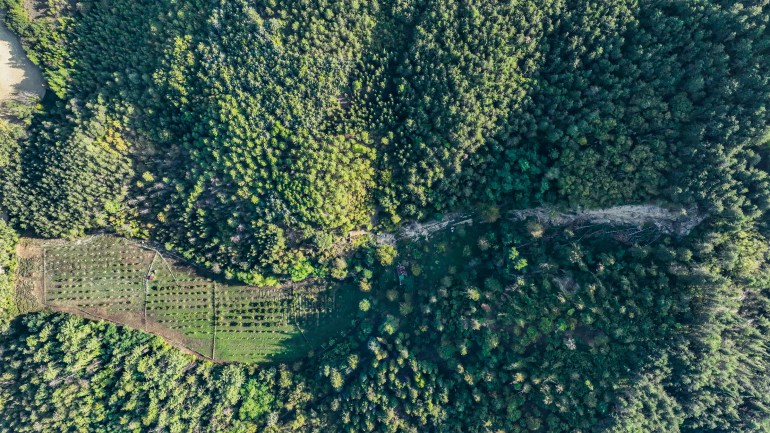 A huge landslide caused by the floods in May is still clearly visible above the farm belonging to Gianni Fagnoli in Rocca San Casciano, Romagna [Cecilia Fasciani / Al Jazeera]
A huge landslide caused by the floods in May is still clearly visible above the farm belonging to Gianni Fagnoli in Rocca San Casciano, Romagna [Cecilia Fasciani / Al Jazeera]
Farmers, too, have suffered huge losses. “When I first saw my field devastated by the landslides, I was speechless. It was apocalyptic,” said Gianni Fagnoli, a bio farmer working in the hills near the town of Rocca San Casciano. He grows mainly regional “forgotten fruits”, traditional varieties of apples or apricots, for instance, which are often neglected by consumers in favour of the mass-produced ones.
His wife, he said, could not help but burst into tears. A 500-metre-long (1,640-foot-long) landslide swept away part of his field and his machinery, while the many fallen trees have rendered the road accessible only by foot.
Fagnoli estimates 40,000 euros ($43,860) in damage to his property alone. Like other farmers, his income has been reduced to almost zero by the ruined harvest and he did not know whether his plants will recover.
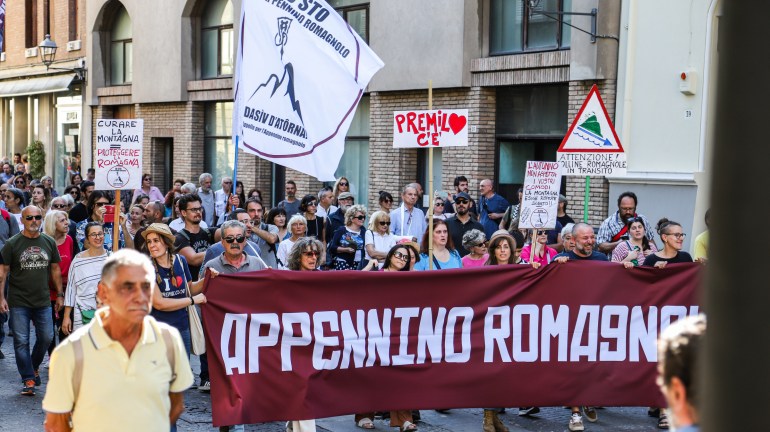 A demonstration on the streets of Forlì by people affected by the floods. Gianni Fagnoli is leading the march [Cecilia Fasciani/Al Jazeera]
A demonstration on the streets of Forlì by people affected by the floods. Gianni Fagnoli is leading the march [Cecilia Fasciani/Al Jazeera]
In June, Fagnoli started an informal group to lobby for the inhabitants of the Apennines hit by the floods. Farmers, citizens and organisations unsatisfied with the government’s slow response joined and organised a protest.
On October 14 in Forli, another city hit by the floods, more than 2,000 protesters took to the streets to demand concrete action.
“We feel abandoned – many are thinking of leaving the cultivation of hills,” Fagnoli said. This could cause a further disaster, he said, as depopulation can lead to rapid land degradation. “The wellbeing of the ecosystem of the hills helps protect those who live in the plain,” Fagnoli said. “But we need money to keep taking care of our environment”.
“We have rolled up our sleeves and immediately started working to restore our houses and businesses,” he added. “But that doesn’t mean that everything is fine now – not at all”.

 Movie
Movie 4 months ago
87
4 months ago
87 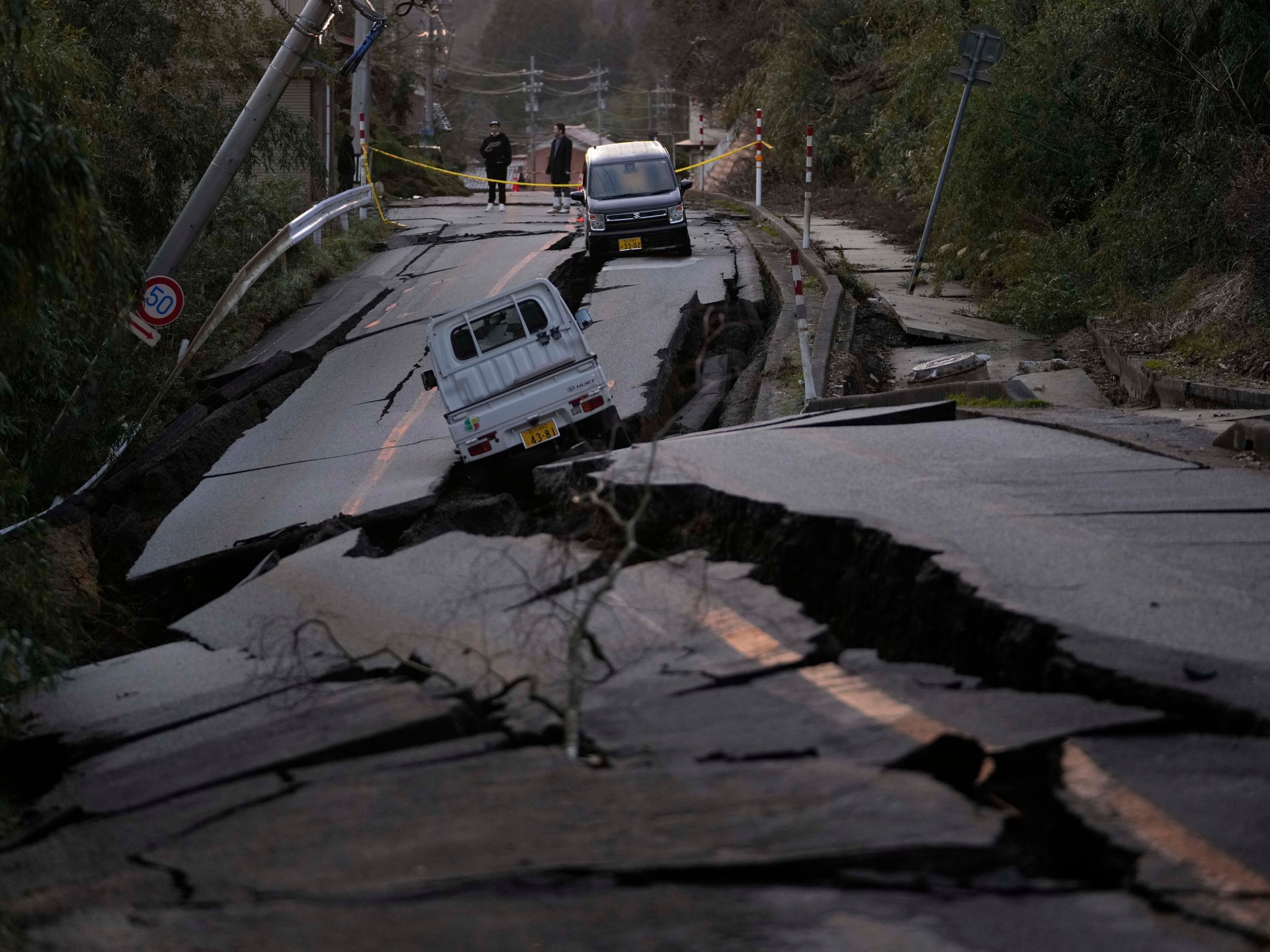
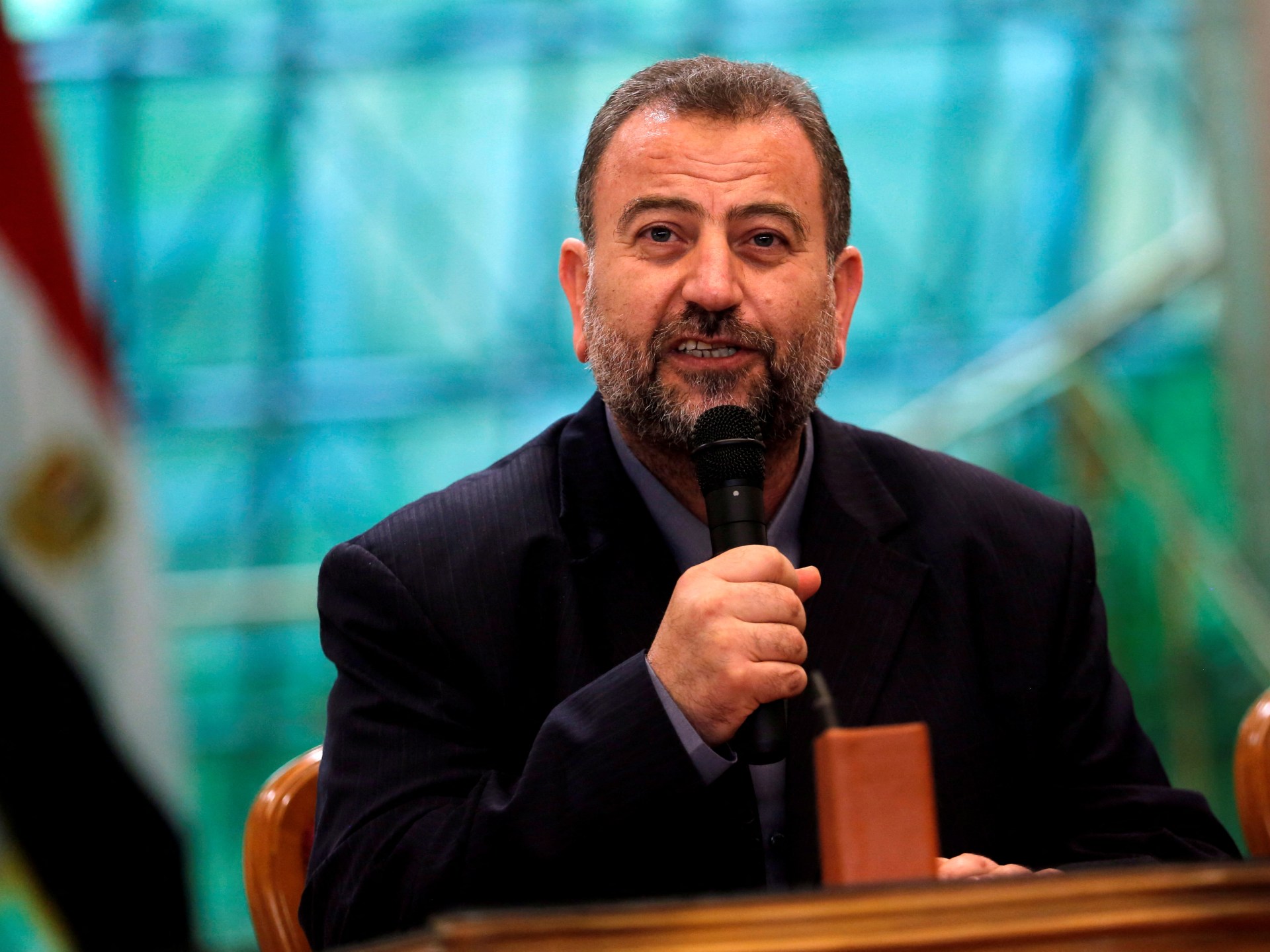





![Presidents Day Weekend Car Sales [2021 Edition] Presidents Day Weekend Car Sales [2021 Edition]](https://www.findthebestcarprice.com/wp-content/uploads/Presidents-Day-Weekend-car-sales.jpg)



 English (United States)
English (United States)